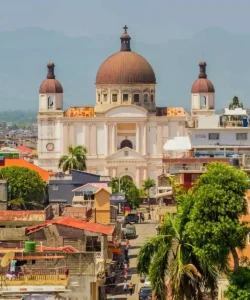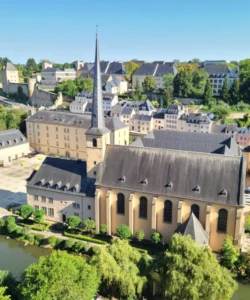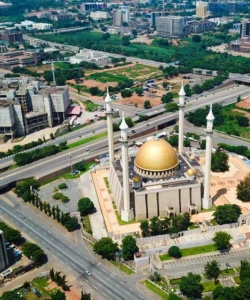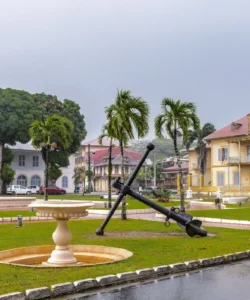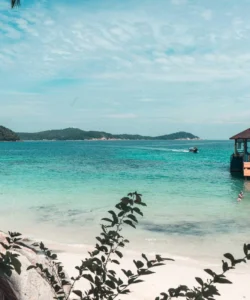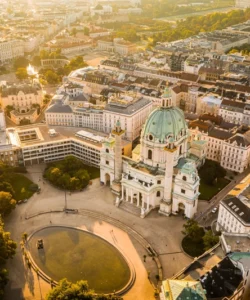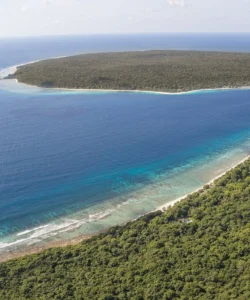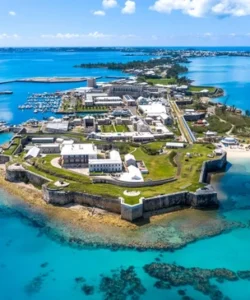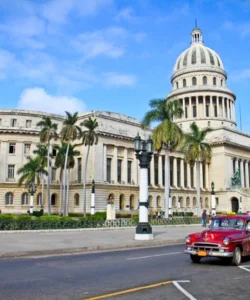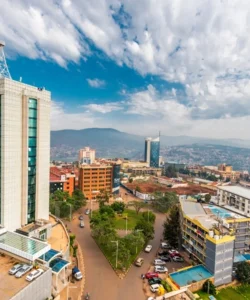The Turks and Caicos Islands are a British Overseas Territory located in the Atlantic Ocean, southeast of the Bahamas. Comprising over 40 islands and cays, only about eight of which are inhabited, the TCI are celebrated for their stunning turquoise waters, pristine white-sand beaches, and world-class diving and snorkeling. They are also a significant offshore financial center.
![]()
Area and Population:
The total land area of the Turks and Caicos Islands is approximately 948 sq. km (366 sq. mi). The population was estimated at around 49,309 in 2023. Providenciales is the most populous island.
Language:
The official language is English. Turks and Caicos Creole, an English-based Creole similar to Bahamian Creole, is also spoken.
Currency:
The official currency is the United States Dollar (USD). No other currencies are accepted, so visitors should exchange money before arriving or at local banks (though exchange rates at banks may be less favorable). Major credit cards are widely accepted.
Religion:
The predominant religion is Protestantism (including Baptist, Church of God, Anglican, Methodist, and Seventh-Day Adventist), followed by Roman Catholicism.
Capital:
The capital city is Cockburn Town, located on Grand Turk. It is the oldest permanent settlement in the country.
Major Cities/Towns:
While Cockburn Town is the capital, Providenciales (often called “Provo”) is the most developed island and the economic and tourism hub, home to the largest population. Other notable inhabited islands include Salt Cay, South Caicos, Middle Caicos, and North Caicos.
Attractions:
The Turks and Caicos Islands are famous for their natural beauty and water-based activities:
- Grace Bay Beach (Providenciales): Consistently ranked among the world’s best beaches, known for its soft white sand and calm, clear turquoise waters. Ideal for swimming, sunbathing, and long walks.
- Turks and Caicos Barrier Reef: The world’s third-largest barrier reef system, offering exceptional opportunities for snorkeling, scuba diving, and exploring vibrant coral gardens and abundant marine life.
- Chalk Sound National Park (Providenciales): A stunning lagoon dotted with thousands of tiny limestone islets and a surreal turquoise color. Perfect for kayaking and paddleboarding.
- Conch Bar Caves (Middle Caicos): The largest non-submerged cave system in the Bahamas-Turks and Caicos island chain, featuring stalactites, stalagmites, and bats.
- Little Water Cay (Iguana Island): A protected sanctuary for the endangered Turks and Caicos rock iguanas, accessible by boat tour.
- Grand Turk Lighthouse (Grand Turk): A historic landmark offering panoramic views of the island and surrounding ocean.
- Turks & Caicos National Museum (Grand Turk): Showcases the islands’ history, including artifacts from shipwrecks and information on the Lucayan Indians.
- Da Conch Shack (Providenciales): An iconic beachfront restaurant famous for its fresh conch dishes and lively atmosphere.
- Horseback Riding: Opportunities to ride horses along the beach and even into the shallow ocean.
Natural Wonders:
The TCI’s natural wonders are primarily linked to its marine environment and unique geological formations:
- Coral Reef System: Extensive and healthy coral reefs teeming with diverse marine life.
- Chalk Sound National Park: Its unique limestone formations and vibrant water color make it a striking natural feature.
- Conch Bar Caves: An impressive underground cave system.
- Flamingo Pond (North and Middle Caicos): A nature reserve where large flocks of pink flamingos can be observed.
- Mudjin Harbour (Middle Caicos): Dramatic limestone cliffs, caves, and a crescent-shaped beach offering breathtaking views.
Architecture:
The architecture in the Turks and Caicos Islands blends traditional Caribbean styles with modern luxury resort designs. Older buildings, particularly in Cockburn Town, feature colonial influences with wooden structures, colorful facades, and verandas. Newer developments on Providenciales are characterized by upscale villas and resorts designed to maximize ocean views and integrate with the natural landscape, often incorporating elements like natural light, ventilation, and green spaces. There are generally no high-rise buildings, maintaining a low-density, exclusive feel.
Roads:
The Turks and Caicos Islands have a network of paved roads, particularly on Providenciales, the most developed island. Driving is on the left-hand side of the road, although most imported cars are left-hand drive (from the US). There are no traffic lights; traffic is managed by roundabouts. While roads generally provide good access, drivers should exercise caution due to varying road conditions, a lack of consistent road rule enforcement, and sometimes reckless driving. Speed bumps and potholes can be present.
Hotels:
The Turks and Caicos Islands are a premier destination for luxury accommodations, primarily on Providenciales. Options range from world-class resorts to boutique hotels and private villas. Some well-known hotels include:
- The Ritz-Carlton, Turks & Caicos
- The Palms Turks and Caicos
- Grace Bay Club
- Windsong on the Reef
- Beaches Turks & Caicos Resort Villages & Spa (all-inclusive, family-oriented)
- The Sands at Grace Bay
- Le Vele Resort
Restaurants:
The culinary scene in the Turks and Caicos Islands is highly regarded, offering a diverse range of international cuisines with a strong emphasis on fresh seafood. Many restaurants offer oceanfront dining experiences.
- Da Conch Shack (Providenciales): Famous for fresh conch in various preparations (salad, fritters, cracked conch), lively atmosphere, and often live music.
- Coco Bistro (Providenciales): A popular upscale restaurant known for its exquisite Caribbean-inspired dishes and charming outdoor setting amongst palm trees.
- Bugaloo’s Conch Crawl (Providenciales): Another excellent spot for fresh conch, with tables directly in the shallow water.
- Parallel23 (The Palms): Offers elegant, globally inspired cuisine.
- Hemingway’s on the Beach (The Sands): Casual beachfront dining with a focus on fresh seafood.
- Mangrove Bay Restaurant (Providenciales): Known for authentic local cuisine.
Cuisine:
Turks and Caicos cuisine is heavily influenced by its Caribbean location and access to fresh seafood, combined with some international flavors.
- Conch: The national dish, prepared in numerous ways: conch salad (ceviche), conch fritters, cracked conch (fried), conch stew, or grilled.
- Fresh Seafood: A staple, including grouper, snapper, mahi-mahi, and lobster (in season), often prepared grilled, fried, or in stews.
- Peas ‘n’ Rice: A common side dish, traditionally made with pigeon peas and rice, often with salt pork or other meat.
- Fish Fry: A popular local event, especially on Providenciales, showcasing various seafood dishes and local music.
- Johnnycake: A simple, slightly sweet flatbread, often served with meals.
- Grilled Lobster: A highly sought-after dish during lobster season (typically August to March).
- Rum Punch: A popular beverage, often served in beach bars.

